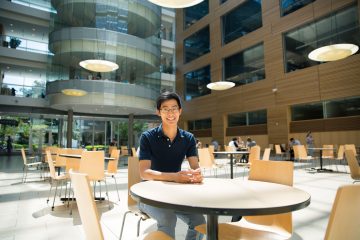We chat with MD/PhD candidate and former UBCMJ co-Editor-in-Chief, Alvin Qiu, who is studying the epigenomics of synovial sarcoma under the joint supervision of Martin Hirst and Torsten Nielsen.

Tell us a little bit about your research project.
Synovial sarcoma is a highly aggressive soft-tissue cancer that predominantly affects adolescents and young adults. This malignancy has limited sensitivity to conventional chemotherapies and thus a poor survival rate. Synovial sarcomas are characterized by a unique chromosomal abnormality, a balanced chromosomal translocation t(X;18)(p11;q11), that ultimately dysregulates critical genes via epigenetic modifications. The exact mechanisms of how these aberrant processes drive this cancer are poorly defined and controversial. The goal of my project is to understand the epigenomics of synovial sarcomas, and ultimately guide the use of novel/emerging epigenetic therapeutic agents in the treatment of this deadly disease.
What do you find interesting in this field of research? How did you initially get involved?
Since epigenetics is a relatively new field of research, it is rapidly evolving and, in many ways, full of mystery. This makes it a compelling field to be in. I was exposed to cancer research during my undergraduate degree and initially came to UBC with a very broad and generic interest in cancer. I met several different supervisors and ultimately found a lab where I could do meaningful work in cancer biology and develop skills as a computational biologist.
What does a typical day look like while working on your project?
I don’t think there is a typical day. In our lab, many students are engaged in both experimental work in the wet lab, as well as computational work in the dry lab. As a result, the day-to-day activities are quite diverse. However, most of my time is currently spent in front of the computer analyzing sequencing data. The data come from epigenetic assays of primary human synovial sarcoma.
What are some of your favourite project-related memories?
It’s hard to have a favourite memory, however, I have enjoyed attending relevant conferences. They have been great opportunities to learn from experts and meet peers in the field. Outside of science, I have been able to keep in touch with other trainees I’ve met at these conferences, and hang out in casual settings. So, one of my favourite experiences is being able to just connect with other young scientists.
What advice would you give to other students interested in getting involved in this field of research?
For many medical students (including myself), we did not come from heavily mathematical or computational backgrounds. As a result, there is a steep learning curve; gaining the skills to do bioinformatic analyses can be challenging since it very different from what we are most familiar with. My overall advice is to be patient and continue to work hard!
What are your research and career aspirations?
My short-term goal is to graduate one day! The long-term goal is to pursue a rewarding career in both clinical medicine and scientific discovery. My perception of a clinician-scientist is someone who has the unique opportunity to integrate both research and clinical medicine. Therefore, in the long term, I aspire to conduct research that has real clinical impact and ultimately improve the lives of patients.